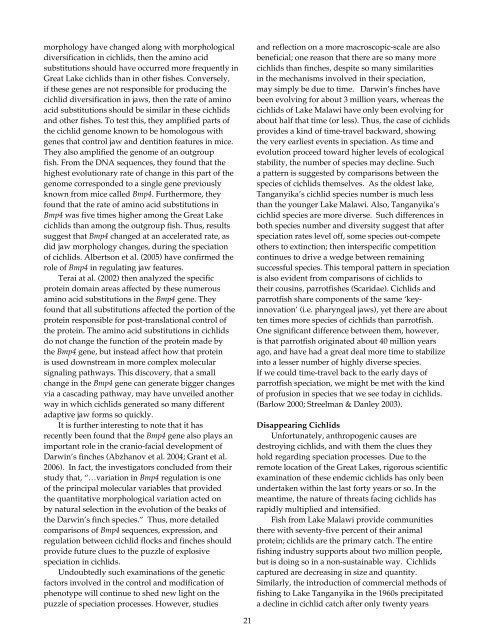A JOURNAL OF ACADEMIC WRITING VOLUME 5
A JOURNAL OF ACADEMIC WRITING VOLUME 5
A JOURNAL OF ACADEMIC WRITING VOLUME 5
You also want an ePaper? Increase the reach of your titles
YUMPU automatically turns print PDFs into web optimized ePapers that Google loves.
morphology have changed along with morphological<br />
diversification in cichlids, then the amino acid<br />
substitutions should have occurred more frequently in<br />
Great Lake cichlids than in other fishes. Conversely,<br />
if these genes are not responsible for producing the<br />
cichlid diversification in jaws, then the rate of amino<br />
acid substitutions should be similar in these cichlids<br />
and other fishes. To test this, they amplified parts of<br />
the cichlid genome known to be homologous with<br />
genes that control jaw and dentition features in mice.<br />
They also amplified the genome of an outgroup<br />
fish. From the DNA sequences, they found that the<br />
highest evolutionary rate of change in this part of the<br />
genome corresponded to a single gene previously<br />
known from mice called Bmp4. Furthermore, they<br />
found that the rate of amino acid substitutions in<br />
Bmp4 was five times higher among the Great Lake<br />
cichlids than among the outgroup fish. Thus, results<br />
suggest that Bmp4 changed at an accelerated rate, as<br />
did jaw morphology changes, during the speciation<br />
of cichlids. Albertson et al. (2005) have confirmed the<br />
role of Bmp4 in regulating jaw features.<br />
Terai at al. (2002) then analyzed the specific<br />
protein domain areas affected by these numerous<br />
amino acid substitutions in the Bmp4 gene. They<br />
found that all substitutions affected the portion of the<br />
protein responsible for post-translational control of<br />
the protein. The amino acid substitutions in cichlids<br />
do not change the function of the protein made by<br />
the Bmp4 gene, but instead affect how that protein<br />
is used downstream in more complex molecular<br />
signaling pathways. This discovery, that a small<br />
change in the Bmp4 gene can generate bigger changes<br />
via a cascading pathway, may have unveiled another<br />
way in which cichlids generated so many different<br />
adaptive jaw forms so quickly.<br />
It is further interesting to note that it has<br />
recently been found that the Bmp4 gene also plays an<br />
important role in the cranio-facial development of<br />
Darwin’s finches (Abzhanov et al. 2004; Grant et al.<br />
2006). In fact, the investigators concluded from their<br />
study that, “…variation in Bmp4 regulation is one<br />
of the principal molecular variables that provided<br />
the quantitative morphological variation acted on<br />
by natural selection in the evolution of the beaks of<br />
the Darwin’s finch species.” Thus, more detailed<br />
comparisons of Bmp4 sequences, expression, and<br />
regulation between cichlid flocks and finches should<br />
provide future clues to the puzzle of explosive<br />
speciation in cichlids.<br />
Undoubtedly such examinations of the genetic<br />
factors involved in the control and modification of<br />
phenotype will continue to shed new light on the<br />
puzzle of speciation processes. However, studies<br />
21<br />
and reflection on a more macroscopic-scale are also<br />
beneficial; one reason that there are so many more<br />
cichlids than finches, despite so many similarities<br />
in the mechanisms involved in their speciation,<br />
may simply be due to time. Darwin’s finches have<br />
been evolving for about 3 million years, whereas the<br />
cichlids of Lake Malawi have only been evolving for<br />
about half that time (or less). Thus, the case of cichlids<br />
provides a kind of time-travel backward, showing<br />
the very earliest events in speciation. As time and<br />
evolution proceed toward higher levels of ecological<br />
stability, the number of species may decline. Such<br />
a pattern is suggested by comparisons between the<br />
species of cichlids themselves. As the oldest lake,<br />
Tanganyika’s cichlid species number is much less<br />
than the younger Lake Malawi. Also, Tanganyika’s<br />
cichlid species are more diverse. Such differences in<br />
both species number and diversity suggest that after<br />
speciation rates level off, some species out-compete<br />
others to extinction; then interspecific competition<br />
continues to drive a wedge between remaining<br />
successful species. This temporal pattern in speciation<br />
is also evident from comparisons of cichlids to<br />
their cousins, parrotfishes (Scaridae). Cichlids and<br />
parrotfish share components of the same ‘keyinnovation’<br />
(i.e. pharyngeal jaws), yet there are about<br />
ten times more species of cichlids than parrotfish.<br />
One significant difference between them, however,<br />
is that parrotfish originated about 40 million years<br />
ago, and have had a great deal more time to stabilize<br />
into a lesser number of highly diverse species.<br />
If we could time-travel back to the early days of<br />
parrotfish speciation, we might be met with the kind<br />
of profusion in species that we see today in cichlids.<br />
(Barlow 2000; Streelman & Danley 2003).<br />
Disappearing Cichlids<br />
Unfortunately, anthropogenic causes are<br />
destroying cichlids, and with them the clues they<br />
hold regarding speciation processes. Due to the<br />
remote location of the Great Lakes, rigorous scientific<br />
examination of these endemic cichlids has only been<br />
undertaken within the last forty years or so. In the<br />
meantime, the nature of threats facing cichlids has<br />
rapidly multiplied and intensified.<br />
Fish from Lake Malawi provide communities<br />
there with seventy-five percent of their animal<br />
protein; cichlids are the primary catch. The entire<br />
fishing industry supports about two million people,<br />
but is doing so in a non-sustainable way. Cichlids<br />
captured are decreasing in size and quantity.<br />
Similarly, the introduction of commercial methods of<br />
fishing to Lake Tanganyika in the 1960s precipitated<br />
a decline in cichlid catch after only twenty years
















